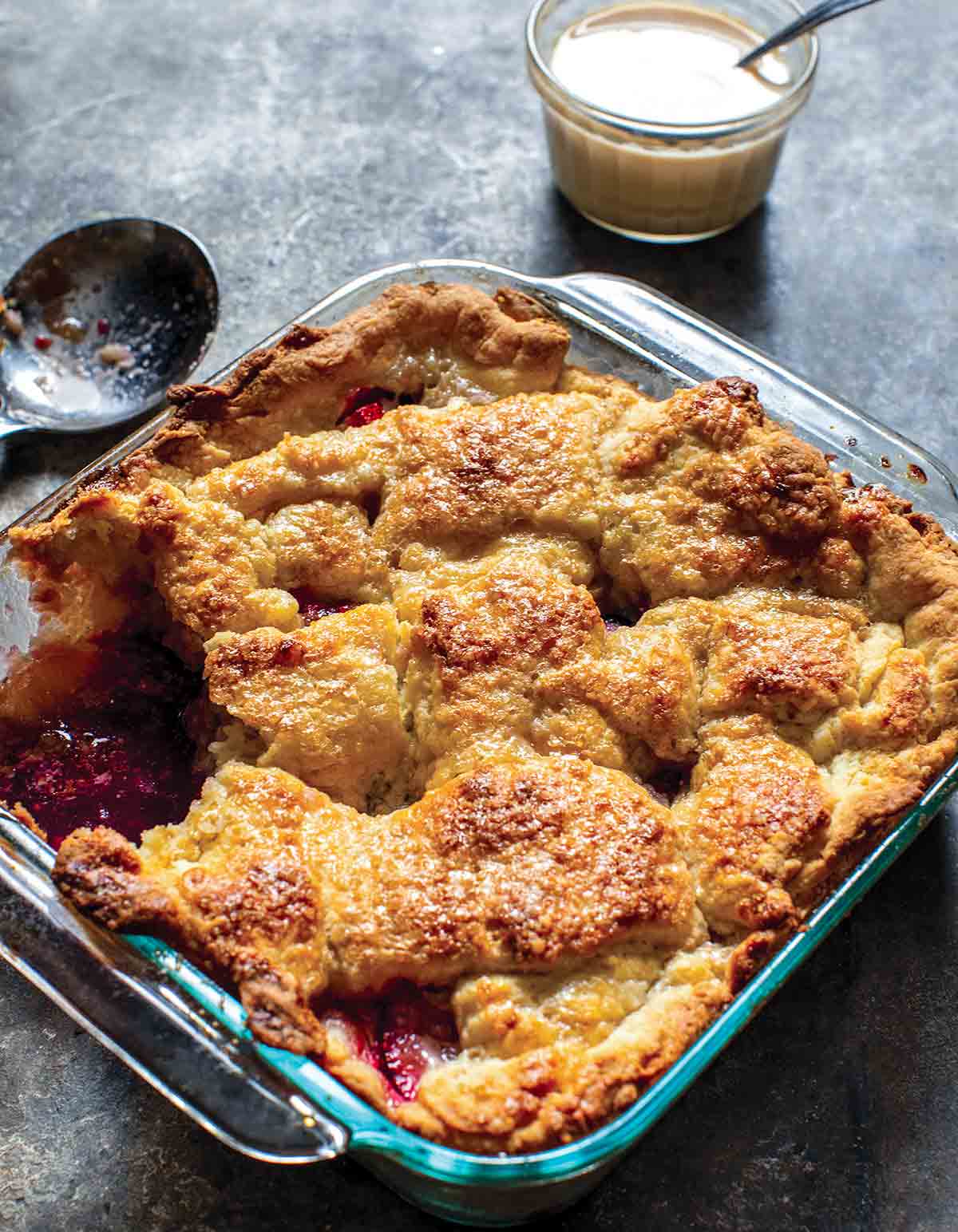
From the western counties of North Carolina, a sonker uses dough that is more like a biscuit, then rolled out, cut in strips, and placed along the sides of the baking pan. A fruit filling is added and some dough strips are laid over the fruit in a quasi-lattice. The filling is very juicy, and it is served with a sweet sauce called a dip.–Kate McDermott
Peach Berry Sonker FAQs
Peaches can be challenging, because we all want the sweetesy, juiciest, most perfect specimen. Here’s a quick read to help you tell if a peach is perfectly ripe.
Hold your peach so that the stem is facing up. Starting at the stem, insert a sharp paring or kitchen knife into the peach until you hit the pit, then roll the knife around the entire peach until you come to the opposite side of the stem, making sure that your blade is in contact with the pit during the entire rotation.
Once you’ve divided your peach in half with this cut, you should be able to twist gently and separate it into two pieces (halves). Pick or cut out the pit, and then slice into the size you’d like.
Sure thing. Raspberries, blueberries, nectarines, apricots, even plums – whatever your favorites are. Just remember that some fruits and berries are sweeter than others, so you may need to adjust the amount of sugar that’s needed.
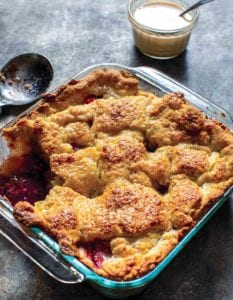
Peach Berry Sonker
Ingredients
For the dough
- 2 sticks (8 oz) unsalted butter, cold and cut into tablespoon-size pieces, plus more for the baking dish
- 2 1/2 cups all-purpose flour
- 1 tablespoon aluminum-free baking powder
- 1/2 teaspoon kosher salt
- 1 cup whole milk
For the filling
- 2 1/2 tablespoons all-purpose flour
- 1 1/4 cups plus 2 tablespoons granulated sugar
- 4 to 5 cups (about 2 lbs) peaches (about 2 lbs | 907 g), pitted and sliced 3/4-inch (18-mm) thick
- 3 cups (about 12 oz) fresh blackberries
- 1 tablespoon vanilla extract
- 5 tablespoons (2 1/2 oz) unsalted butter
- 1 large egg white plus 2 teaspoons water, lightly beaten with a fork
- 2 tablespoons sparkling sugar, demerara sugar, or turbinado sugar, for sprinkling
For the milk dip
- 2 1/2 teaspoons cornstarch
- 1/4 cup plus 2 tablespoons granulated sugar
- Pinch of salt
- 1 1/2 cups whole milk
- 1 teaspoon vanilla extract
Instructions
Make the dough
- Preheat the oven to 375°F (190°C). Butter the sides of an 11-by-11-inch (27-by-27-cm) or 9-by-13-inch (23-by-33-cm) baking dish.
- In a medium bowl, combine the flour, baking powder, salt, and pieces of cold butter. With a pastry cutter, knives, mezzaluna, or your fingers, cut and smoosh the butter into the dry ingredients until it is roughly mixed.
- Add the milk and mix until the dough is tacky.
- Place half the dough on a well-floured board. Pat the dough out a bit, roll it out to about 3/8 inch (1 cm) thick, and cut into long 2 1/2-inch (6 cm) wide strips.
- Lift a strip and tuck it around the sides of the pan. Repeat with the other strips until the pan is encircled with the wide strips. It’s okay if you have to piece them together. The bottom of the pan will be doughless.
Make the filling
- Place the flour and 1 1/4 cups granulated sugar in the baking dish and mix around a bit with your fingers or a fork to combine.
☞ TESTER TIP: If your fruit is ripe and sweet, you'll probably want to reduce the amount of sugar to 3/4 cup.
- In a medium bowl, combine the peaches, blackberries, and vanilla, and gently mix together. Turn the filling onto the flour and sugar in the baking dish.
- Sprinkle 2 tablespoons sugar over the top of the fruit.
- Break up the butter into small pieces and place over the top of the fruit evenly.
- Roll out the remaining dough to 3/8 inch (1 cm) thick and cut into long 2 1/2-inch (6 cm) wide strips. Lay the strips over the top of the filling to form a rough lattice. An offset spatula is a great help in getting the rolled out strips onto the top of the filling.
- In a small bowl, mix the egg and water together with a fork and brush some on top of the lattice strips. Sprinkle with 2 tablespoons of sparkling sugar.
☞ TESTER TIP: If your baking dish seems precariously full, place it on a foil-lined baking sheet in case the filling overflows during baking.
- Bake the sonker for 30 minutes. While the sonker is baking, make the milk dip.
Make the milk dip
- In a medium saucepan over low heat, whisk together the cornstarch, sugar, and salt. Whisk in the milk.
- Increase the heat to medium-high and bring to a boil while whisking constantly. Cook for 2 minutes more while whisking.
- Remove from the heat, stir in the vanilla, and let cool.
- After the sonker has baked for 30 minutes, carefully remove it from the oven, place it on a flat surface, and close the oven door. Pour 1/2 cup of the hot milk dip over the top.
- Return the sonker to the oven and bake until the filling is bubbling around the edges and up through the crust, about 30 minutes more. The crust should be a beautiful golden brown when finished. If it seems to be browning too quickly, loosely place a piece of foil over the sonker and continue to bake.
- Let cool for 20 to 30 minutes.
- Serve the sonker warm or at room temperature, keeping in mind it’s best the day it’s made. Pass any remaining milk dip on the side (and you may even want to double the milk dip to ensure ample for drizzling). Any leftover milk dip can be refrigerated.
Notes
Any Fruit Sonker
The filling is very adaptable, and you can use whatever is available. Try peaches, berries, or cherries mixed together, or a single fruit filling. Kate McDermott, the author of this recipe who is also known as The Pie Lady, once used a combination of green gooseberries, white currants, red currants, peaches, and a few tart cherries. Use 7 to 8 cups (about 2 quarts, 1.8 L) fruit.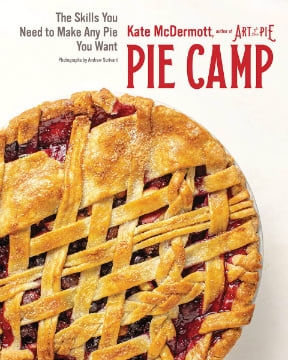
Explore More with AI
Nutrition
Nutrition information is automatically calculated, so should only be used as an approximation.
Recipe Testers’ Reviews
Not a pie, not a cobbler, not a crisp. This curious fruit dessert turned out to be something quite familiar: juicy fruit filling with buttery pastry crust. And milk dip? The dip was sort of like melted vanilla ice cream.
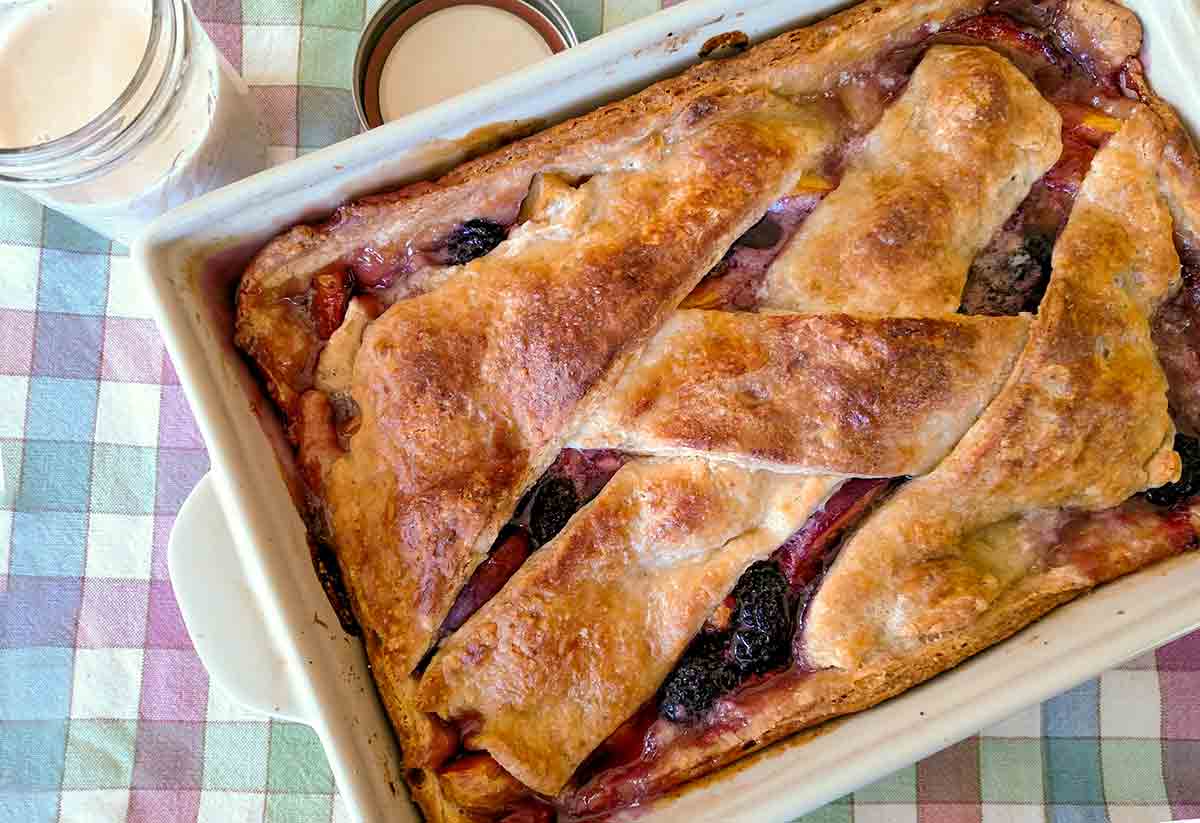
This peach berry sonker was easy from start to finish, and having no bottom crust made it even simpler. Rolling out each half of the dough into an oval and cutting it lengthwise into four wide strips worked well. The two long strips in the center lined the long sides of the baking dish (and the middle “X” of the lattice top) and the remaining strips were used for the short sides of the dish (and outer edges of the lattice).
Approaching this like a rustic crostata, I didn’t trim off the uneven edges of the strips or took care to cover all the corners perfectly. In the end the sonker turned out looking just fine, and the crust didn’t get soggy even after the leftover portion cooled to room temperature.
If your peaches are at their peak in terms of ripeness, or you just prefer to hold back the sweetness, I think you can omit the additional 2 tablespoons of sugar (or even reduce the amount to 3/4 cup) and skip the sprinkling of sugar. I used turbinado sugar for sprinkling the top crust. There was JUST enough dough to cover the four sides of the baking dish.
I did need to cover the top crust 15 min after the milk dip was poured on and the sonker was returned to the oven. I’m not sure what the effect of pouring hot milk dip over the half-baked sonker.
This is a terrific recipe, and the peach berry sonker is beautiful to behold, a delight to present, and delicious. We are of the camp that loves crisps, cobblers, slumps, all the wonderful and clever variations on baked summer fruit bounty. The sonker is a new option for us and we surely will make again.
The biscuit dough comes together easily, and half the recipe lined the edges of the pan perfectly.
For the filling, we used peaches and blackberries. Our lattice didn’t cover as much of the sonker as in the sample photo, but the finished baked dessert was so beautiful, it didn’t matter at all. We sprinkled the top biscuit dough with turbinado sugar.
The milk dip (completely new to us, another fun element) made about 1 1/2 cups. We used whole milk. The finished dip pours like heavy cream and is quite sweet.
We baked the sonker for exactly 60 minutes total. We didn’t need to cover it with foil.
Our peaches were ripe and sweet, as were the berries, and the result was a VERY sweet dessert. Next time we’ll use less sugar and may add a bit of lemon juice and zest.
We’re on the fence about the milk dip—it was an intriguing new element, but we wonder whether it is essential (the cornstarch may be needed to help thicken the fruit?). For a topping, we’d opt for a drizzle of unsweetened heavy cream.
The sonker was most successful on Day 1. On Day 2, the flavor was still terrific, but the biscuit was a bit dried out.
This is a crowd-pleasing dessert and could serve 12 to 15.
A peach crumble or cobbler is one of those true signs of summer, impatiently waiting for the really great peaches to appear. I will brave parking downtown for market day when Frog Hollow and other Brentwood growers begin to appear with amazing peach selections, but even if you buy peaches in the grocery store, baking them brings out flavors that remind you of all your past summers. Combining them with another fruit, like blackberries, you get a gorgeous rhubarb color that is all comfort and optimism.
Sonkers are relatively new to me—I had also followed Jenny Field’s sonker trail postings, and made one as soon as she shared her findings. It turns out this is a super regional specialty, and describing the milk dip to folks who had lived elsewhere in North Carolina, I was met with the same puzzled curiosity I might respond when presented with a grunt or buckle. All wonderful ways to experience summer fruits and a pastry-like envelope.
This version includes a quick pastry that comes together with a light hand mixing and isn’t any more work than a batter but is even more satisfying. I started with an old-fashioned wire pastry cutter, then finished rubbing the butter in roughly with my fingers. This dough doesn’t rest and is soft and moistly shaggy. (I added an extra 1/4 cup flour, then only needed a little bit of flour flicked onto the board to roll out without sticking.) I also finally had an reason to use my lattice cutting roller, making the last part easy and super pretty, rolled on a flexible mat which I carefully inverted to lay and spread open over the fruit.
The milk dip is what my English spouse calls a simple custard (without egg), not fancy custard like a crème anglaise, but more like Bird’s Custard without the coloring. Using it on the dough partway through cooking was a new idea. It seems to enhance the caramelization as well as the lightness of the milk-doped pastry, which puffs up also partly to the addition baking powder. These details set this aside from a regular pastry or batter and make this sing, the kind of dish you want to make for a special occasion, but will consider whenever lush fruit presents itself in abundance.
For dessert, passing a jug of the milk dip is perfect (though when I have some of this for breakfast, I add yogurt, and justify having it twice a day).
I think the fruit filling in this recipe could be sweetened less, especially as you get better and better peaches further into the season. This pastry dough is really great—it’s unsweetened and easy to work with (NOTE: I did add a bit of flour, but then did not need much to roll it out).
Although I had not heard of a sonker before last year, now they are one of my favorite alternatives to a crumble or cobbler. I also noticed that a strawberry sonker has been added to the most recent Joy of Cooking, although it is a different take (precooked fruit and a batter poured in).
First off, the hilarious name of this dessert had all my testers excited and eager to try it just based on that. My sonker, made with peaches and raspberries, was a huge hit! Everyone loved it, including my 2-year-old niece who kept begging for more.
The dough topping was incredible and I would make this recipe again just for more of it. It’s very sweet, especially with the milk dip, but no one complained. I do think you can reduce the amount of sugar mixed with the fruit if that is your preference.
A word of advice, however; while it resembles a cobbler, it is far more time consuming than a cobbler. It’s not quite as much work as a lattice-pie, but a close second. Given that it’s a bit of work to assemble, I would suggest taking it up a notch—don’t use a 9-by-13-inch baking dish, which doesn’t do it justice. Use a big pie dish and treat it like a bottomless pie. Put a pan underneath while it’s baking, just in case your sonker bubbles over a bit.
There was no benefit to putting the sugar and flour mixture on the bottom…I was expecting some sort of magic, like a miracle crust, as a result, but nope! I think it could have all been tossed in with the fruit and dumped in. Perhaps a tsp of cornstarch could be added to the fruit to help thicken the sauce, as mine was a bit soupy.

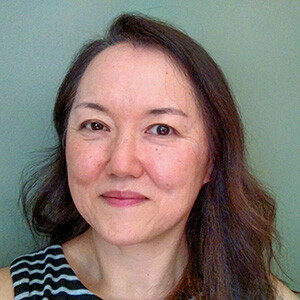













Thanks so much for posting this! As an FYI for those making it, a sonker is quite sweet, and the dip is too. And just as the recipe says, it is VERY juicy. That’s just how it’s made!
Be Happy, Make Pie…and Sonker!
Thanks for that, Kate!